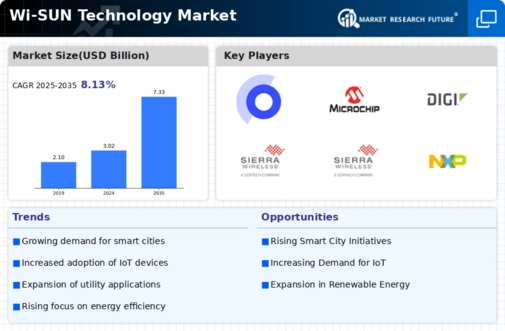Top Industry Leaders in the WI SUN Technology Market
Competitive Landscape of WI-SUN Technology Market
The WI-SUN technology market is experiencing explosive growth, driven by its potential to revolutionize connectivity for smart cities, industrial automation, and the Internet of Things (IoT). This burgeoning market attracts established players and innovative newcomers alike, creating a dynamic and competitive landscape. Here, we delve into the key aspects of this competitive environment, including:
Key Players:
- Analog Devices, Inc.
- Cisco Systems Inc.
- Texas Instruments Incorporated
- Itron
- Brilliant Holdings Inc.
- Murata Manufacturing Co. Ltd.
- Rohm Semiconductor
- Renesas Electronics Corporation
- Landis + Gyr
- Toshiba Corporation
Strategies Adopted:
- Product Portfolio Expansion: Key players are expanding their product portfolios to cater to diverse applications and cater to various market segments. This includes developing hardware solutions like chipsets, modules, and gateways, along with software solutions like network management and data analytics platforms.
- Strategic Partnerships: Collaborative partnerships are prevalent in the WI-SUN market. Players are partnering with system integrators, solution providers, and technology companies to expand their reach, offer integrated solutions, and leverage expertise.
- Focus on Standardization: Collaboration and adherence to industry standards like Wi-SUN FAN and WMP are crucial for market growth and ensuring interoperability. Key players actively participate in standardization bodies and contribute to the development of interoperable solutions.
- Focus on Emerging Applications: Players are actively exploring and developing solutions for emerging applications like smart agriculture, connected buildings, and asset tracking. This allows them to capture new market opportunities and remain ahead of the competition.
Factors for Market Share Analysis:
- Product Portfolio: A diverse and comprehensive product portfolio catering to various applications and market segments holds significant weight in market share analysis.
- Market Reach and Distribution Channels: An extensive network of distributors, partners, and system integrators allows players to reach a wider audience and secure market share.
- Brand Reputation and Customer Loyalty: A strong brand image and established customer base contribute significantly to market share, highlighting trust and reliability.
- Innovation and R&D Investment: Continuous investment in research and development, leading to innovative and advanced solutions, plays a crucial role in differentiating players and attracting customers.
- Pricing Strategy and Cost Competitiveness: Competitive pricing strategies and cost-effective solutions are essential for attracting customers and gaining market share in a price-sensitive market.
New and Emerging Companies:
Several new and emerging companies are entering the WI-SUN market, bringing fresh ideas, innovative solutions, and competitive pricing. These companies are often more agile and focused on specific niches, challenging established players and contributing to the overall market growth. Examples include:
- Satori: A startup specializing in low-power, long-range mesh networking solutions for IoT applications.
- Oi Electric Co., Ltd.: A Japanese company offering energy-efficient WI-SUN chipsets and modules.
- Procubed: A provider of smart grid solutions with a focus on WI-SUN-based network management and analytics.
- Ad-sol nissin: A company offering WI-SUN-based solutions for smart factories and industrial automation.
Current Company Investment Trends:
Current investment trends in the WI-SUN market indicate a focus on:
- R&D for advanced solutions: Players are investing heavily in research and development to create more efficient, secure, and scalable solutions. This includes exploring new technologies like LPWAN and NB-IoT for seamless integration.
- Software development: Investments are directed towards developing advanced software solutions for network management, data analytics, and security. This includes leveraging AI and machine learning to enhance network performance and optimize resource utilization.
- Strategic partnerships and acquisitions: Players are actively seeking partnerships and acquisitions to expand their reach, access new technologies, and gain market share.
- Vertical market expansion: Investments are directed towards developing solutions tailored to specific vertical markets, such as smart cities, utilities, and industrial automation. This allows players to cater to the unique needs of these markets and capture new opportunities.
Latest Company Updates:
May 2023 - IIIT Hyderabad and Silicon Labs have of late launched Wi-Sun Fan 1.1 network. The network will support the FAN or Field Area Network 1.1 specification as the continuation to the launch of FAN 1.0 network in 2022 September.
Wi-SUN is a protocol that is open-standards allowing interoperable solutions with the help of open-source software with the multi-layer security. This will allow municipalities, utilities, and other enterprises in deploying low power, low range wireless mesh networks that connect endless number of IoT nodes. The Wi-SUN network utilizes the unlicensed bad that too sans any additional network infra adds up to the current modes of the sensor communications comprising LORA and Wi-Fi that enables sensors in connecting to the cloud in a hassle-free way.
The Wi-SUN will allow devices in communicating with one another in the mesh network. Rather than depending on a central hub for routing data amid devices, every device could act as a relay & pass data on to the other devices within the network. In fact, this will help in creating a more reliable and resilient network with no single point of failure.
The technology can be utilized by local governments/municipalities, utilities, and service providers for a large scale IoT wireless communication network outdoor. It allows entities in deploying a lower-power, long-range wireless mesh network that connect untold number of IoT nodes.
Phase 2 network launch is a vital move to allow innovators in addressing the chief issues in the sustainable urbanization. It will act as a backbone for smart city applications in the future.

